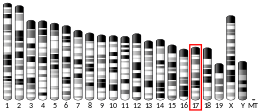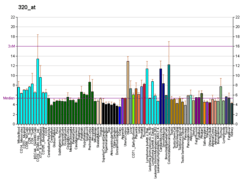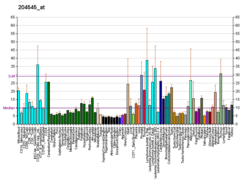PEX6
Peroxisome assembly factor 2 is a protein that in humans is encoded by the PEX6 gene.[5][6] PEX6 is an AAA ATPase that localizes to the peroxisome. PEX6 forms a hexamer with PEX1[7][8] and is recruited to the membrane by PEX26.[9]
Function
From yeast to plants to humans, there is only one verified function of PEX6; PEX6 (and PEX1) removes PEX5 from the peroxisomal membrane so that PEX5 may do additional rounds of peroxisomal import. Human PEX6 can genetically complement plant pex6 mutants, which highlights functional conservation.[10] Work with pex6 mutants in Arabidopsis thaliana has shown that PEX6 may have a role in consuming oil body (plant-specific lipid droplets).[11] Work with yeast pex6 mutants has shown that PEX6 is a key player in the autophagy of peroxisomes called pexophagy.[12]
Related diseases
Mutations in the genes encoding PEX6, along with PEX1, are the leading causes of peroxisomal biogenesis disorders[13], such as Zellweger Syndrome spectrum, infantile Refsum disease, and neonatal adrenoleukodystrophy. These genetic diseases are autosomal recessive and occur in 1 of every 50,000 births.[14]
References
- GRCh38: Ensembl release 89: ENSG00000124587 - Ensembl, May 2017
- GRCm38: Ensembl release 89: ENSMUSG00000002763 - Ensembl, May 2017
- "Human PubMed Reference:". National Center for Biotechnology Information, U.S. National Library of Medicine.
- "Mouse PubMed Reference:". National Center for Biotechnology Information, U.S. National Library of Medicine.
- Yahraus T, Braverman N, Dodt G, Kalish JE, Morrell JC, Moser HW, Valle D, Gould SJ (June 1996). "The peroxisome biogenesis disorder group 4 gene, PXAAA1, encodes a cytoplasmic ATPase required for stability of the PTS1 receptor". The EMBO Journal. 15 (12): 2914–23. doi:10.1002/j.1460-2075.1996.tb00654.x. PMC 450231. PMID 8670792.
- "Entrez Gene: PEX6 peroxisomal biogenesis factor 6".
- Tamura S, Shimozawa N, Suzuki Y, Tsukamoto T, Osumi T, Fujiki Y (April 1998). "A cytoplasmic AAA family peroxin, Pex1p, interacts with Pex6p". Biochemical and Biophysical Research Communications. 245 (3): 883–6. doi:10.1006/bbrc.1998.8522. PMID 9588209.
- Gardner BM, Chowdhury S, Lander GC, Martin A (March 2015). "The Pex1/Pex6 complex is a heterohexameric AAA+ motor with alternating and highly coordinated subunits". Journal of Molecular Biology. 427 (6 Pt B): 1375–88. doi:10.1016/j.jmb.2015.01.019. PMC 4355278. PMID 25659908.
- Matsumoto N, Tamura S, Fujiki Y (May 2003). "The pathogenic peroxin Pex26p recruits the Pex1p-Pex6p AAA ATPase complexes to peroxisomes". Nature Cell Biology. 5 (5): 454–60. doi:10.1038/ncb982. PMID 12717447.
- Zolman BK, Bartel B (February 2004). "An Arabidopsis indole-3-butyric acid-response mutant defective in PEROXIN6, an apparent ATPase implicated in peroxisomal function". Proceedings of the National Academy of Sciences of the United States of America. 101 (6): 1786–91. doi:10.1073/pnas.0304368101. PMC 341854. PMID 14745029.
- Gonzalez KL, Fleming WA, Kao YT, Wright ZJ, Venkova SV, Ventura MJ, Bartel B (October 2017). "Disparate peroxisome-related defects in Arabidopsis pex6 and pex26 mutants link peroxisomal retrotranslocation and oil body utilization". The Plant Journal. 92 (1): 110–128. doi:10.1111/tpj.13641. PMC 5605450. PMID 28742939.
- Nuttall JM, Motley AM, Hettema EH (May 2014). "Deficiency of the exportomer components Pex1, Pex6, and Pex15 causes enhanced pexophagy in Saccharomyces cerevisiae". Autophagy. 10 (5): 835–45. doi:10.4161/auto.28259. PMC 5119063. PMID 24657987.
- Waterham HR, Ebberink MS (September 2012). "Genetics and molecular basis of human peroxisome biogenesis disorders". Biochimica et Biophysica Acta (BBA) - Molecular Basis of Disease. 1822 (9): 1430–41. doi:10.1016/j.bbadis.2012.04.006. PMID 22871920.
- Braverman NE, Raymond GV, Rizzo WB, Moser AB, Wilkinson ME, Stone EM, Steinberg SJ, Wangler MF, Rush ET, Hacia JG, Bose M (March 2016). "Peroxisome biogenesis disorders in the Zellweger spectrum: An overview of current diagnosis, clinical manifestations, and treatment guidelines". Molecular Genetics and Metabolism. 117 (3): 313–21. doi:10.1016/j.ymgme.2015.12.009. PMC 5214431. PMID 26750748.
Further reading
- Maruyama K, Sugano S (January 1994). "Oligo-capping: a simple method to replace the cap structure of eukaryotic mRNAs with oligoribonucleotides". Gene. 138 (1–2): 171–4. doi:10.1016/0378-1119(94)90802-8. PMID 8125298.
- Fukuda S, Shimozawa N, Suzuki Y, Zhang Z, Tomatsu S, Tsukamoto T, Hashiguchi N, Osumi T, Masuno M, Imaizumi K, Kuroki Y, Fujiki Y, Orii T, Kondo N (December 1996). "Human peroxisome assembly factor-2 (PAF-2): a gene responsible for group C peroxisome biogenesis disorder in humans". American Journal of Human Genetics. 59 (6): 1210–20. PMC 1914864. PMID 8940266.
- Suzuki Y, Yoshitomo-Nakagawa K, Maruyama K, Suyama A, Sugano S (October 1997). "Construction and characterization of a full length-enriched and a 5'-end-enriched cDNA library". Gene. 200 (1–2): 149–56. doi:10.1016/S0378-1119(97)00411-3. PMID 9373149.
- Tamura S, Shimozawa N, Suzuki Y, Tsukamoto T, Osumi T, Fujiki Y (April 1998). "A cytoplasmic AAA family peroxin, Pex1p, interacts with Pex6p". Biochemical and Biophysical Research Communications. 245 (3): 883–6. doi:10.1006/bbrc.1998.8522. PMID 9588209.
- Geisbrecht BV, Collins CS, Reuber BE, Gould SJ (July 1998). "Disruption of a PEX1-PEX6 interaction is the most common cause of the neurologic disorders Zellweger syndrome, neonatal adrenoleukodystrophy, and infantile Refsum disease". Proceedings of the National Academy of Sciences of the United States of America. 95 (15): 8630–5. doi:10.1073/pnas.95.15.8630. PMC 21127. PMID 9671729.
- Zhang Z, Suzuki Y, Shimozawa N, Fukuda S, Imamura A, Tsukamoto T, Osumi T, Fujiki Y, Orii T, Wanders RJ, Barth PG, Moser HW, Paton BC, Besley GT, Kondo N (1999). "Genomic structure and identification of 11 novel mutations of the PEX6 (peroxisome assembly factor-2) gene in patients with peroxisome biogenesis disorders". Human Mutation. 13 (6): 487–96. doi:10.1002/(SICI)1098-1004(1999)13:6<487::AID-HUMU9>3.0.CO;2-T. PMID 10408779.
- Matsumoto N, Tamura S, Moser A, Moser HW, Braverman N, Suzuki Y, Shimozawa N, Kondo N, Fujiki Y (2001). "The peroxin Pex6p gene is impaired in peroxisomal biogenesis disorders of complementation group 6". Journal of Human Genetics. 46 (5): 273–7. doi:10.1007/s100380170078. PMID 11355018.
- Tamura S, Matsumoto N, Imamura A, Shimozawa N, Suzuki Y, Kondo N, Fujiki Y (July 2001). "Phenotype-genotype relationships in peroxisome biogenesis disorders of PEX1-defective complementation group 1 are defined by Pex1p-Pex6p interaction". The Biochemical Journal. 357 (Pt 2): 417–26. doi:10.1042/0264-6021:3570417. PMC 1221968. PMID 11439091.
- Raas-Rothschild A, Wanders RJ, Mooijer PA, Gootjes J, Waterham HR, Gutman A, Suzuki Y, Shimozawa N, Kondo N, Eshel G, Espeel M, Roels F, Korman SH (April 2002). "A PEX6-defective peroxisomal biogenesis disorder with severe phenotype in an infant, versus mild phenotype resembling Usher syndrome in the affected parents". American Journal of Human Genetics. 70 (4): 1062–8. doi:10.1086/339766. PMC 379104. PMID 11873320.
- Matsumoto N, Tamura S, Fujiki Y (May 2003). "The pathogenic peroxin Pex26p recruits the Pex1p-Pex6p AAA ATPase complexes to peroxisomes". Nature Cell Biology. 5 (5): 454–60. doi:10.1038/ncb982. PMID 12717447.
- Warner DR, Roberts EA, Greene RM, Pisano MM (December 2003). "Identification of novel Smad binding proteins". Biochemical and Biophysical Research Communications. 312 (4): 1185–90. doi:10.1016/j.bbrc.2003.11.049. PMID 14651998.
- Colland F, Jacq X, Trouplin V, Mougin C, Groizeleau C, Hamburger A, Meil A, Wojcik J, Legrain P, Gauthier JM (July 2004). "Functional proteomics mapping of a human signaling pathway". Genome Research. 14 (7): 1324–32. doi:10.1101/gr.2334104. PMC 442148. PMID 15231748.
- Furuki S, Tamura S, Matsumoto N, Miyata N, Moser A, Moser HW, Fujiki Y (January 2006). "Mutations in the peroxin Pex26p responsible for peroxisome biogenesis disorders of complementation group 8 impair its stability, peroxisomal localization, and interaction with the Pex1p x Pex6p complex". The Journal of Biological Chemistry. 281 (3): 1317–23. doi:10.1074/jbc.M510044200. PMID 16257970.
- Tamura S, Yasutake S, Matsumoto N, Fujiki Y (September 2006). "Dynamic and functional assembly of the AAA peroxins, Pex1p and Pex6p, and their membrane receptor Pex26p". The Journal of Biological Chemistry. 281 (38): 27693–704. doi:10.1074/jbc.M605159200. PMID 16854980.





